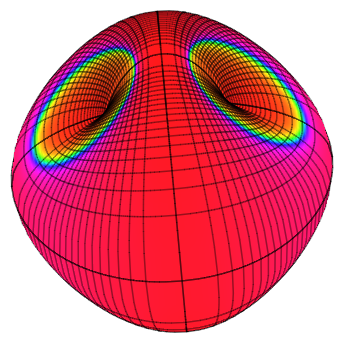Publications
. Local wellposedness of Maxwell systems with retarded material laws in low regularity. Nonlinear Differ. Equ. Appl., 33(1):Article No. 13, January 2026. URL https://doi.org/10.1007/s00030-025-01156-1. [preprint]
. Maxwell equations with localized internal damping: strong and polynomial stability. Commun. Anal. Mech., 17(4):849–877, October 2025. URL https://doi.org/10.3934/cam.2025034. [preprint]
. Strichartz estimates for Maxwell equations in media: the partially anisotropic case. Commun. Partial Differ. Equ., 49(4):279–332, April 2024. URL https://doi.org/10.1080/03605302.2024.2341055. [preprint]
. Normal trace inequalities and decay of solutions to the nonlinear Maxwell equations with absorbing boundary. J. Math. Anal. Appl., 532(1):127915, April 2024. URL https://doi.org/10.1016/j.jmaa.2023.127915. [preprint]
. Strichartz estimates for Maxwell equations in media: The fully anisotropic case. J. Hyperbolic Differ. Equ., 20(4):917–966, December 2023. URL https://doi.org/10.1142/S0219891623500285. [preprint]
. Rigorous envelope approximation for interface wave packets in Maxwell's equations with two dimensional localization. SIAM J. Math. Anal., 55(6):6898–6939, December 2023. URL https://doi.org/10.1137/22M1501611. [preprint] [files]
. Wellposedness for a $(1+1)$-dimensional wave equation with quasilinear boundary conditions. Nonlinearity, 36(12):6712–6746, December 2023. URL https://doi.org/10.1088/1361-6544/ad03d0. [preprint]
. Local wellposedness of quasilinear Maxwell equations with conservative interface conditions. Commun. Math. Sci., 20(8):2265–2313, November 2022. URL https://doi.org/10.4310/CMS.2022.v20.n8.a6. [preprint]
. On quasilinear Maxwell equations in two dimensions. Pure Appl. Anal., 4(2):313–365, October 2022. URL https://doi.org/10.2140/paa.2022.4.313. [preprint]
. Fourier transform of surface-carried measures of two-dimensional generic surfaces and applications. Commun. Pure Appl. Anal., 21(9):2873–2889, September 2022. URL https://doi.org/10.3934/cpaa.2022079. [preprint]
. Time-harmonic solutions for Maxwell's equations in anisotropic media and Bochner–Riesz estimates with negative index for non-elliptic surfaces. Ann. Henri Poincaré, 23(5):1831–1882, May 2022. URL https://doi.org/10.1007/s00023-021-01144-y. [preprint] [files]
. Global Strichartz estimates for an inhomogeneous Maxwell system. Commun. Partial Differ. Equ., 47(3):630–675, March 2022. URL https://doi.org/10.1080/03605302.2021.1998910. [preprint]
. Regularity theory for nonautonomous Maxwell equations with perfectly conducting boundary conditions. J. Math. Anal. Appl., 506(1):125646, February 2022. URL https://doi.org/10.1016/j.jmaa.2021.125646. [preprint]
. Resolvent estimates for time-harmonic Maxwell's equations in the partially anisotropic case. J. Fourier Anal. Appl., 28(2):16, February 2022. URL https://doi.org/10.1007/s00041-022-09912-y. [preprint]
. A limiting absorption principle for Helmholtz systems and time-harmonic isotropic Maxwell's equation. J. Funct. Anal., 281(11):109233, December 2021. URL https://doi.org/10.1016/j.jfa.2021.109233. [preprint]
. Local wellposedness of quasilinear Maxwell equations with absorbing boundary conditions. Evol. Equ. Control Theory, 10(1):155–198, March 2021. URL https://doi.org/10.3934/eect.2020061. [preprint]
. Boundary stabilization of quasilinear Maxwell equations. J. Differential Equations, 268(2):784–812, January 2020. URL https://doi.org/10.1016/j.jde.2019.08.032. [preprint]
. Exponential decay of quasilinear Maxwell equations with interior conductivity. Nonlinear Differ. Equ. Appl., 26(6):Paper No. 51, December 2019. URL https://doi.org/10.1007/s00030-019-0595-1. [preprint]
. On a Kelvin–Voigt viscoelastic wave equation with strong delay. SIAM J. Math. Anal., 51(6):4382–4412, November 2019. URL https://doi.org/10.1137/18M1219308. [preprint]
. Long-time behavior of quasilinear thermoelastic Kirchhoff–Love plates with second sound. Nonlinear Anal., 186:219–258, September 2019. URL https://doi.org/10.1016/j.na.2019.02.019. [preprint]
. Global well-posedness and exponential stability for heterogeneous anisotropic Maxwell's equations under a nonlinear boundary feedback with delay. J. Math. Anal. Appl., 475(1):278–312, July 2019. URL https://doi.org/10.1016/j.jmaa.2019.02.042. [preprint]
. Local wellposedness of nonlinear Maxwell equations with perfectly conducting boundary conditions. J. Differential Equations, 266(8):5012–5063, April 2019. URL https://doi.org/10.1016/j.jde.2018.10.019. [preprint]
. Strong solutions to a nonlinear stochastic Maxwell equation with a retarded material law. J. Evol. Equ., 18(3):1427–1469, September 2018. URL https://doi.org/10.1007/s00028-018-0448-0. [preprint]
. Blow-up for nonlinear Maxwell equations. Electron. J. Differ. Equ., Paper No. 73, 9, March 2018. URL https://ejde.math.txstate.edu/Volumes/2018/73/abstr.html. [preprint]
. Multidimensional thermoelasticity for nonsimple materials—well-posedness and long-time behavior. Appl. Anal., 96(9):1561–1585, February 2017. URL https://doi.org/10.1080/00036811.2017.1295447. [preprint]
Preprints
. Exponential decay of the linear Maxwell system due to conductivity near the boundary. CRC 1173 Preprint 2026/3, Karlsruhe Institute of Technology, January 2026.
. Strichartz estimates for Maxwell equations on domains with perfectly conducting boundary conditions. CRC 1173 Preprint 2022/78, Karlsruhe Institute of Technology, December 2022.
. Local wellposedness of Maxwell systems with scalar-type retarded material laws. CRC 1173 Preprint 2022/68, Karlsruhe Institute of Technology, November 2022.
Theses
. Semilinear and quasilinear stochastic evolution equations in Banach spaces. PhD thesis, Karlsruhe Institute of Technology (KIT), December 2017.
. Local wellposedness of nonlinear Maxwell equations. PhD thesis, Karlsruhe Institute of Technology (KIT), July 2017.

